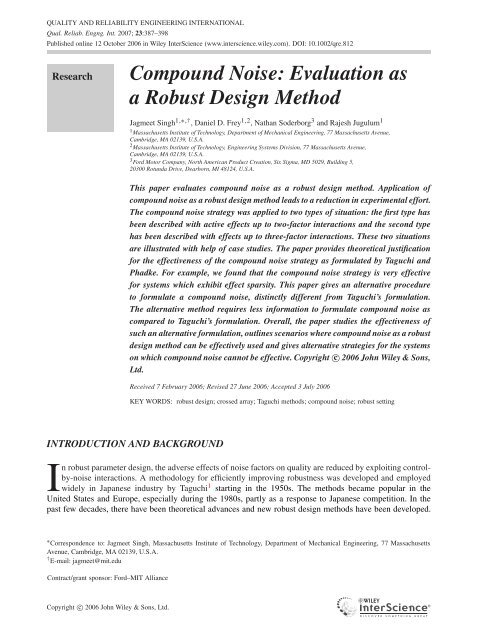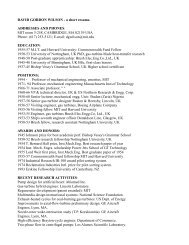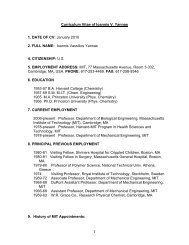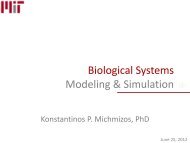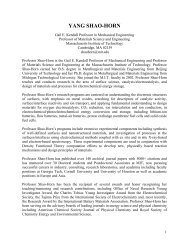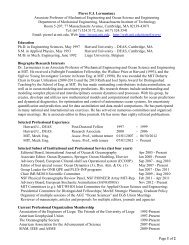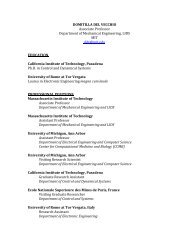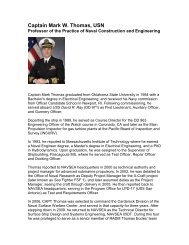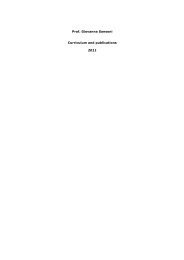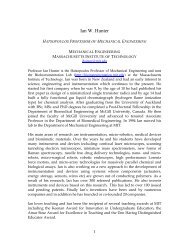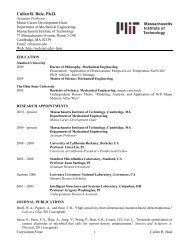Compound Noise - MIT Department of Mechanical Engineering
Compound Noise - MIT Department of Mechanical Engineering
Compound Noise - MIT Department of Mechanical Engineering
Create successful ePaper yourself
Turn your PDF publications into a flip-book with our unique Google optimized e-Paper software.
QUALITY AND RELIABILITY ENGINEERING INTERNATIONAL<br />
Qual. Reliab. Engng. Int. 2007; 23:387–398<br />
Published online 12 October 2006 in Wiley InterScience (www.interscience.wiley.com). DOI: 10.1002/qre.812<br />
Research<br />
<strong>Compound</strong> <strong>Noise</strong>: Evaluation as<br />
a Robust Design Method<br />
Jagmeet Singh 1,∗,† ,DanielD.Frey 1,2 , Nathan Soderborg 3 and Rajesh Jugulum 1<br />
1 Massachusetts Institute <strong>of</strong> Technology, <strong>Department</strong> <strong>of</strong> <strong>Mechanical</strong> <strong>Engineering</strong>, 77 Massachusetts Avenue,<br />
Cambridge, MA 02139, U.S.A.<br />
2 Massachusetts Institute <strong>of</strong> Technology, <strong>Engineering</strong> Systems Division, 77 Massachusetts Avenue,<br />
Cambridge, MA 02139, U.S.A.<br />
3 Ford Motor Company, North American Product Creation, Six Sigma, MD 5029, Building 5,<br />
20300 Rotunda Drive, Dearborn, MI 48124, U.S.A.<br />
This paper evaluates compound noise as a robust design method. Application <strong>of</strong><br />
compound noise as a robust design method leads to a reduction in experimental effort.<br />
The compound noise strategy was applied to two types <strong>of</strong> situation: the first type has<br />
been described with active effects up to two-factor interactions and the second type<br />
has been described with effects up to three-factor interactions. These two situations<br />
are illustrated with help <strong>of</strong> case studies. The paper provides theoretical justification<br />
for the effectiveness <strong>of</strong> the compound noise strategy as formulated by Taguchi and<br />
Phadke. For example, we found that the compound noise strategy is very effective<br />
for systems which exhibit effect sparsity. This paper gives an alternative procedure<br />
to formulate a compound noise, distinctly different from Taguchi’s formulation.<br />
The alternative method requires less information to formulate compound noise as<br />
compared to Taguchi’s formulation. Overall, the paper studies the effectiveness <strong>of</strong><br />
such an alternative formulation, outlines scenarios where compound noise as a robust<br />
design method can be effectively used and gives alternative strategies for the systems<br />
on which compound noise cannot be effective. Copyright c○ 2006 John Wiley & Sons,<br />
Ltd.<br />
Received 7 February 2006; Revised 27 June 2006; Accepted 3 July 2006<br />
KEY WORDS: robust design; crossed array; Taguchi methods; compound noise; robust setting<br />
INTRODUCTION AND BACKGROUND<br />
In robust parameter design, the adverse effects <strong>of</strong> noise factors on quality are reduced by exploiting controlby-noise<br />
interactions. A methodology for efficiently improving robustness was developed and employed<br />
widely in Japanese industry by Taguchi 1 starting in the 1950s. The methods became popular in the<br />
United States and Europe, especially during the 1980s, partly as a response to Japanese competition. In the<br />
past few decades, there have been theoretical advances and new robust design methods have been developed.<br />
∗ Correspondence to: Jagmeet Singh, Massachusetts Institute <strong>of</strong> Technology, <strong>Department</strong> <strong>of</strong> <strong>Mechanical</strong> <strong>Engineering</strong>, 77 Massachusetts<br />
Avenue, Cambridge, MA 02139, U.S.A.<br />
† E-mail: jagmeet@mit.edu<br />
Contract/grant sponsor: Ford–<strong>MIT</strong> Alliance<br />
Copyright c○ 2006 John Wiley & Sons, Ltd.
388 J. SINGH ET AL.<br />
As discussed in a recent review paper by Robinson et al. 2 , research efforts in robust design have led to novel<br />
performance measures, new experimental designs, and alternatives to Taguchi’s methods building upon response<br />
surface methodology. One <strong>of</strong> the principal goals <strong>of</strong> recent research has been to reduce run sizes while still<br />
attaining good outcomes. The focus <strong>of</strong> this paper will be compound noise, which is also intended to reduce run<br />
sizes.<br />
<strong>Compound</strong> noise is a technique in which multiple noise factors are varied simultaneously as if they were a<br />
single noise factor. In most documented applications, an outer array <strong>of</strong> noise factors is replaced by the compound<br />
noise factor being varied between two levels. Taguchi 1 and Phadke 3 suggested forming compound noise factors<br />
based on the directionality <strong>of</strong> the noise factor effects thereby creating two conditions that represent, in some<br />
sense, opposite extremes. Du et al. 4 suggested forming compound noises based on the conditions <strong>of</strong> the two<br />
‘most probable points <strong>of</strong> inverse reliability’. This approach to compounding is better able to account for skew<br />
in the distribution <strong>of</strong> system performance. This new concept <strong>of</strong> compound noise, like Taguchi’s, is based on two<br />
‘extreme settings’ <strong>of</strong> noise factors.<br />
Hou 5 studied the conditions that will make compound noise yield robust settings for systems. Hou said<br />
‘extreme settings should exist for compound noise to work’. We find below that compound noise can be effective<br />
even when extreme settings do not exist. The conditions mentioned in ‘compound noise factor theory’ turn out<br />
to be the sufficient conditions. In later sections we extend the analysis to determine conditions under which<br />
compound noise will predict a robust setting. Hou’s formulation was limited to systems that had active effects<br />
up to two-factor interactions. We extend the formulation to systems that can have active effects up to three-factor<br />
interactions.<br />
<strong>Compound</strong> noise can be considered as an extension <strong>of</strong> supersaturated designs (SSD). This concept initially<br />
originated with a paper by Satterthwaite 6 . SSDs were assumed to <strong>of</strong>fer a potentially useful way to investigate<br />
many factors with few experiments. Holcomb and Carlyle 7 discussed the construction and evaluation <strong>of</strong> SSDs.<br />
Holcomb et al. 8 outlined the analysis <strong>of</strong> SSDs. <strong>Compound</strong> noise is an unbalanced SSD. Allen and Bernshteyn 9<br />
discussed the advantages <strong>of</strong> unbalanced SSDs in terms <strong>of</strong> performance and affordability. Heyden et al. 10 argued<br />
that SSDs can be used to estimate variance <strong>of</strong> response, which can be used as a measure <strong>of</strong> robustness rather<br />
than using it to find main effects. SSDs ‘do not allow estimation <strong>of</strong> the effects <strong>of</strong> the individual factors because<br />
<strong>of</strong> confounding between the main effects’. However, ‘estimation <strong>of</strong> the separate factor effects is not necessarily<br />
required’ in improving robustness. Using compound noise as a robust design method we try to estimate the<br />
robustness <strong>of</strong> the system at a given control factor setting. The setting that improves this estimate is taken as the<br />
predicted robust setting.<br />
The aim <strong>of</strong> this study is to explore the effectiveness <strong>of</strong> compound noise as a robust design method. <strong>Engineering</strong><br />
systems show certain regularities, one <strong>of</strong> which is the hierarchical ordering principle (see Wu and Hamada 11<br />
and Chipman et al. 12 ). We classified systems based on the hierarchical ordering principle. The classes are as<br />
follows.<br />
• Strong hierarchy systems are those that have only main effects and two-factor interactions active.<br />
Some small three-factor interactions might be present in such systems, but they are not active.<br />
• Weak hierarchy systems are those that also have active three-factor interactions.<br />
We apply compound noise to three strong hierarchy systems and three weak hierarchy systems and analyze<br />
robustness gain. There are three main questions we want to address in this paper.<br />
• Why is compound noise effective in achieving a robust setting in certain cases, but ineffective in other<br />
cases<br />
• How can we measure the effectiveness <strong>of</strong> a compound noise strategy<br />
• Do we need to know the directionality <strong>of</strong> noise factors to use compound noise<br />
We analyze a compound noise factor strategy for six case studies and explore reasons for the effectiveness or<br />
ineffectiveness <strong>of</strong> the strategy. We then present the conditions for compound noise to work. These conditions are<br />
an extension <strong>of</strong> Hou 5 . First, we present conditions for strong and weak hierarchy systems. Second, we present<br />
the effectiveness <strong>of</strong> the compound noise strategy in real scenarios using fractional factorial arrays for control<br />
Copyright c○ 2006 John Wiley & Sons, Ltd. Qual. Reliab. Engng. Int. 2007; 23:387–398<br />
DOI: 10.1002/qre
COMPOUND NOISE: EVALUATION AS A ROBUST DESIGN METHOD 389<br />
Table I. Results from full factorial control factor array and two-level compound noise<br />
Matching <strong>of</strong><br />
all control Matching <strong>of</strong><br />
Measure Existence <strong>of</strong> factors with control factors<br />
<strong>of</strong> sparsity extreme Number <strong>of</strong> their robust with their Improvement<br />
System Hierarchy <strong>of</strong> effects settings (Hou 5 ) replications setting (%) robust setting (%) ratio (%)<br />
Op Amp Strong 0.105 Existing 100 96 99.2 99.2<br />
PNM Strong 0.132 Non-existent 100 98 99 99.5<br />
Journal bearing Strong 0.28 Existing 100 97.8 98.8 98.84<br />
CSTR Weak 0.647 Non-existent 100 10 55.17 58.4<br />
Temperature Weak 0.725 Non-existent 100 5 29.25 30.65<br />
Control circuit<br />
Slider crank Weak 0.119 Existing 100 95 98 98.5<br />
and noise factors. Finally, we present a procedure to determine an outer array for robust design experiments,<br />
which can be used by practitioners.<br />
CASE STUDIES<br />
We analyzed six case studies. Three <strong>of</strong> them exhibited strong hierarchy: passive neuron model (PNM; Tawfik and<br />
Durand 13 ), operational amplifier (Op Amp; Phadke 3 ) and journal bearing: half Sommerfeld solution (Hamrock<br />
et al. 14 ). Three case studies exhibited weak hierarchy: the continuous-stirred tank reactor (CSTR; Kalagnanam<br />
and Diwekar 15 ), the temperature control circuit (Phadke 3 ) and the slider crank (Gao et al. 16 ). For each case study<br />
we ran full factorial control and noise factor crossed array experiments. These runs were used to determine the<br />
effect coefficients for the main effects, two-factor interactions and three-factor interactions. Lenth’s method<br />
(Lenth 17 ) was employed to determine the active effects. The full factorial results were also used to determine<br />
the most robust setting for all six systems.<br />
In order to formulate compound noise for robust design experiments, we found the directionality <strong>of</strong> noise<br />
factors on the system response for all six systems. For each system we ran a full factorial design in control<br />
factors crossed with two-level compound noise. Pure experimental error was introduced into the system’s<br />
response. The error was <strong>of</strong> the order <strong>of</strong> the active main effects. From Lenth’s method, we can estimate the<br />
average magnitude <strong>of</strong> active main effects. Pure experimental error introduced into the system’s response was<br />
normally distributed with zero mean and standard deviation as the average magnitude <strong>of</strong> active main effects.<br />
The compound noise strategy performed extremely well for the PNM, Op Amp, journal bearing and slider<br />
crank. Table I the shows results from the robust design experiments.<br />
The third column <strong>of</strong> Table I shows the measure <strong>of</strong> sparsity <strong>of</strong> effects, which is the ratio <strong>of</strong> active effects in a<br />
system to the total number <strong>of</strong> effects that can be present in the system. The sparsity <strong>of</strong> effects means that among<br />
several experimental effects examined in any experiment, a small fraction will usually prove to be significant<br />
(Box and Meyer 18 and Wu and Hamada 11,19 ). The sixth column <strong>of</strong> Table I shows how well the predicted robust<br />
setting from compound noise experiments matches with the actual robust setting as found by carrying out full<br />
factorial control and noise array experiments. The seventh column <strong>of</strong> Table I shows the percentage <strong>of</strong> control<br />
factors whose robust setting matched for full factorial and compound noise experiments.<br />
At the predicted robust setting <strong>of</strong> control factors from compound noise experiments, we found the<br />
corresponding variance <strong>of</strong> the system’s response from full factorial experiments. Full factorial experiments<br />
yield the optimal variance <strong>of</strong> the system’s response and the average variance <strong>of</strong> the response at all control<br />
factor settings. With this knowledge, variance can be improved from the average value to the optimal value,<br />
which is the maximum possible improvement. For compound noise experiments the variance <strong>of</strong> the response<br />
can be improved from the average value to the variance at the predicted robust setting. The ratio <strong>of</strong> achieved<br />
Copyright c○ 2006 John Wiley & Sons, Ltd. Qual. Reliab. Engng. Int. 2007; 23:387–398<br />
DOI: 10.1002/qre
390 J. SINGH ET AL.<br />
improvement to maximum possible improvement is called the improvement ratio. The average <strong>of</strong> this measure<br />
for all replicates is shown in the eighth column <strong>of</strong> Table I.<br />
From Table I we can see that compound noise strategy works reasonably well for the Op Amp, PNM, journal<br />
bearing and slider crank, but not nearly as well for the CSTR and the temperature control circuit.<br />
CONDITIONS FOR COMPOUND NOISE TO BE COMPLETELY EFFECTIVE<br />
Hou 5 gave conditions under which a compound noise strategy will predict the robust setting for a system.<br />
One <strong>of</strong> the conditions for compound noise to work is the existence <strong>of</strong> extreme settings. The extreme settings<br />
<strong>of</strong> compound noise are those that maximize and minimize the system’s response to capture noise variations.<br />
However, we found that in some systems (e.g., PNM; Tawfik and Durand 13 ) the compound noise strategy would<br />
work even if extreme settings do not exist. So the conditions outlined in Theorem 4 <strong>of</strong> Hou 5 are sufficient but<br />
not necessary conditions for compound noise to work.<br />
For strong hierarchy systems the response y can be expressed as<br />
m∑ m∑<br />
y = f(x 1 ,x 2 ,...,x l ) + β j z j +<br />
j=1<br />
j=1 i=1<br />
l∑<br />
γ ij x i z j (1)<br />
where f(x 1 ,x 2 ,...,x l ) is a general function in the control factors x i ,z j (j = 1,...,m)denotes the noise<br />
factors affecting the system, β j denotes the effect intensity <strong>of</strong> noise factor j and γ ij denotes the effect intensities<br />
<strong>of</strong> control-by-noise interactions present in the system. Control factors can have two settings, either −1 or1.<br />
(Control factor variability can be represented as separate noise factors.) <strong>Noise</strong> factors are in the range −1 to1<br />
and are independent, with zero mean and a variance <strong>of</strong> 1. <strong>Noise</strong> factors are symmetric about 0. The variance <strong>of</strong><br />
y with respect to z j termsisgivenby<br />
( l∑ ( m∑ )<br />
Var z (y) = C + 2 β j γ ij x i +<br />
i=1 j=1<br />
l∑<br />
( m∑ )<br />
γ ij γ kj<br />
)x i x k<br />
j=1<br />
where C is a constant. The robust setting <strong>of</strong> the system is such that the variance <strong>of</strong> the response is minimized<br />
with respect to noise factors. It can be represented as<br />
[ ( l∑ ( m∑ ) l∑<br />
( m∑ )]<br />
X ≡ arg min β j γ ij x i + γ ij γ kj<br />
)x i x k (3)<br />
x i<br />
i=1 j=1 j=1<br />
where X is the setting <strong>of</strong> the x i terms that minimizes the variance.<br />
If we follow Taguchi’s formulation <strong>of</strong> compound noise, based on the directionality <strong>of</strong> noise factors, then<br />
responses at two levels <strong>of</strong> compound noise will be given by<br />
m∑<br />
( l∑<br />
y + = f(x 1 ,x 2 ,...,x l ) + β j + γ ij x i<br />
)sign(β j ) (4)<br />
y − = f(x 1 ,x 2 ,...,x l ) −<br />
j=1<br />
k=1<br />
i
COMPOUND NOISE: EVALUATION AS A ROBUST DESIGN METHOD 391<br />
where C 1 is a constant. The estimated robust setting <strong>of</strong> the system is such that the estimated variance <strong>of</strong> the<br />
response is minimized with respect to the compound noise levels. It can be represented as<br />
[ ( l∑ ( m∑<br />
X <strong>Compound</strong> ≡ arg min<br />
x i<br />
i=1 j=1<br />
|β j |<br />
m∑<br />
sign(β j )γ ij<br />
)x i +<br />
j=1<br />
l∑<br />
k=1<br />
i
392 J. SINGH ET AL.<br />
System<br />
Table II. Results from resolution III control and noise factor array<br />
Hierarchy<br />
Measure<br />
<strong>of</strong> sparsity<br />
<strong>of</strong> effects<br />
Number <strong>of</strong><br />
replications<br />
Matching <strong>of</strong><br />
all control<br />
factors with<br />
their robust<br />
setting<br />
(%)<br />
Matching <strong>of</strong><br />
control factors<br />
with their<br />
robust setting<br />
(%)<br />
Improvement<br />
ratio<br />
(%)<br />
Op Amp Strong 0.105 100 98 99.6 99.91<br />
CSTR Weak 0.647 100 None 76.5 96.5<br />
Temperature Weak 0.725 100 28 55 87<br />
control circuit<br />
Slider crank Weak 0.119 100 91 95.5 97.6<br />
System<br />
Table III. Results from resolution III control factor array and two-level compound noise<br />
Hierarchy<br />
Measure <strong>of</strong><br />
sparsity <strong>of</strong><br />
effects<br />
Number <strong>of</strong><br />
replications<br />
Matching <strong>of</strong><br />
all control<br />
factors with<br />
their robust<br />
setting<br />
(%)<br />
Matching <strong>of</strong><br />
control factors<br />
with their<br />
robust setting<br />
(%)<br />
Improvement<br />
ratio<br />
(%)<br />
Improvement<br />
ratio (from<br />
resolution III<br />
noise array)<br />
(%)<br />
Op Amp Strong 0.105 100 86 97.2 99.37 99.91<br />
CSTR Weak 0.647 100 None 41.17 39.8 96.5<br />
Temperature Weak 0.725 100 None 43.5 25.2 87<br />
control circuit<br />
Slider crank Weak 0.119 100 89 94 96.5 97.6<br />
System<br />
Table IV. Average results from full factorial control factor array and two-level random compound noise<br />
Hierarchy<br />
Measure <strong>of</strong><br />
sparsity <strong>of</strong><br />
effects<br />
Number <strong>of</strong><br />
replications<br />
Matching <strong>of</strong><br />
all control<br />
factors with<br />
their robust<br />
setting<br />
(%)<br />
Matching <strong>of</strong><br />
control factors<br />
with their<br />
robust setting<br />
(%)<br />
Improvement<br />
ratio<br />
(%)<br />
Improvement<br />
ratio (from<br />
Taguchi’s<br />
compound<br />
noise)<br />
(%)<br />
Op Amp Strong 0.105 1000 30.8 73 80.2 99.2<br />
PNM Strong 0.132 2 4 = 16 50 68.75 79.9 99.5<br />
Journal bearing Strong 0.28 2 3 = 8 100 100 100 98.84<br />
CSTR Weak 0.647 2 6 = 64 54.69 70.3 67.6 58.4<br />
Temperature Weak 0.725 2 5 = 32 68.75 76.56 74.75 30.65<br />
control circuit<br />
Slider crank Weak 0.119 2 5 = 32 50 70 55.2 98.5<br />
The compound noise strategy also does not perform well with a resolution III control factor array for the<br />
temperature control circuit. The improvement ratio drops from 87% for a resolution III noise array to 25%<br />
for two-level compound noise.<br />
In the formulation <strong>of</strong> compound noise as suggested by Taguchi 1 and Phadke 3 , we need to know the<br />
directionality <strong>of</strong> noise factors on the system’s response. We need to run some fractional factorial experiments<br />
on the system to gather information about the directionality <strong>of</strong> noise factors. We tried a different formulation<br />
Copyright c○ 2006 John Wiley & Sons, Ltd. Qual. Reliab. Engng. Int. 2007; 23:387–398<br />
DOI: 10.1002/qre
COMPOUND NOISE: EVALUATION AS A ROBUST DESIGN METHOD 393<br />
<strong>of</strong> compound noise. <strong>Noise</strong> factor settings can be picked randomly to form a two-level random compound noise.<br />
We ran such a compound noise strategy with a full factorial control factor array for each <strong>of</strong> the six case studies.<br />
Table IV presents the average results from these experiments.<br />
The Op Amp has 21 noise factors, so there can be 2 21 combinations <strong>of</strong> random compound noise. Instead<br />
we ran 1000 such combinations <strong>of</strong> random compound noise for the Op Amp. The PNM has four noise factors.<br />
Hence, there are 2 4 combinations <strong>of</strong> random compound noise for the PNM. The journal bearing has three, the<br />
CSTR has six and the temperature control circuit and slider crank have five noise factors each. From Table IV<br />
we see that such a formulation <strong>of</strong> compound noise is very effective on average. Except for the slider crank<br />
system, random compound noise can achieve improvement ratios greater than 68% on average for all systems.<br />
For the slider crank system, half <strong>of</strong> the replications gave a robust setting <strong>of</strong> the system and half <strong>of</strong> them led to<br />
poor settings. Hence, had we used random compound noise with care for the slider crank system we would have<br />
attained a robust setting.<br />
CONCLUSIONS<br />
The use <strong>of</strong> compound noise in robust design experiments leads to a reduction in experimental effort. In this<br />
paper we tried to gage the effectiveness <strong>of</strong> compound noise as a robust design method. We built upon the<br />
conditions given by Hou 5 for the effectiveness <strong>of</strong> compound noise. Also we extended the conditions to include<br />
the possibility <strong>of</strong> three-factor interactions.<br />
<strong>Compound</strong> noise as a robust design strategy is very effective on the systems that exhibit effect sparsity. We ran<br />
compound noise on six case studies. The compound noise strategy predicted robust settings for the systems that<br />
exhibited effect sparsity.<br />
The given formulation <strong>of</strong> compound noise was adopted from Taguchi 1 and Phadke 3 . For such a formulation<br />
we need to know the directionality <strong>of</strong> noise factors on the system’s response. To know the directionality <strong>of</strong> noise<br />
factors we need to run fractional factorial experiments on the system. We tried to measure the effectiveness <strong>of</strong><br />
random compound noise for which we do not need to know the directionality <strong>of</strong> noise factors. We found that<br />
such a formulation <strong>of</strong> compound noise can be very effective in obtaining high robustness gains. The reason why<br />
such a formulation <strong>of</strong> compound noise is very effective is that active effects in the system are sparse. Even if we<br />
randomly compound noise there is a very low probability that two opposite acting interactions get compounded<br />
with each other. The results outlined in Tables I–IV did not change significantly on removing experimental error<br />
from observations. In this case we will obtain the same conclusions regarding the effectiveness <strong>of</strong> all robust<br />
design methods on all six systems that we studied.<br />
These results may be used in the overall approach to deploying compound noise as a robust design strategy.<br />
The flowchart in Figure 1 presents our suggestion for implementing these findings in practice. First <strong>of</strong> all,<br />
practicing engineers must define the scenario including the system to be improved, what objectives are being<br />
sought and what design variables can be altered.<br />
At this point, it may be possible to consider what assumptions can be made regarding effect sparsity. It should<br />
be noted here that we do not argue that engineers need to make a factual determination <strong>of</strong> effect sparsity.<br />
The experience on the system should be used to make decision.<br />
If engineers decide that effects are dense, then they should follow the procedure on the right-hand side <strong>of</strong><br />
Figure 1. In this case, the results in this paper suggest that instead <strong>of</strong> using compound noise, a fractional factorial<br />
noise factor array should be used as the outer array.<br />
If engineers decide that effects are sparse, then they should follow the procedure on the left-hand side <strong>of</strong><br />
Figure 1. At this point, engineers should consider the directionality <strong>of</strong> noise factors. If the directionality <strong>of</strong> noise<br />
factors is known, then they should use Taguchi and Phadke’s formulation <strong>of</strong> compound noise. Otherwise they<br />
can formulate random compound noise as the outer array. From Table IV, we can say that random compound<br />
noise is effective for the systems for which effect sparsity holds. However, experience, judgment and knowledge<br />
<strong>of</strong> engineering and science are critical in formulating such a compound noise. It is hoped that the procedure<br />
proposed here in Figure 1 will be <strong>of</strong> value to practitioners seeking to implement robust design efficiently and<br />
using minimum resources.<br />
Copyright c○ 2006 John Wiley & Sons, Ltd. Qual. Reliab. Engng. Int. 2007; 23:387–398<br />
DOI: 10.1002/qre
394 J. SINGH ET AL.<br />
Define the robust design scenario<br />
Sparse<br />
Assumptions about<br />
effect sparsity<br />
Dense<br />
Yes<br />
Is the directionality <strong>of</strong><br />
noise factors known<br />
No<br />
Use fractional/full<br />
factorial array as<br />
outer array (instead<br />
<strong>of</strong> compound<br />
noise)<br />
Use compound noise<br />
(as defined by Taguchi,<br />
Phadke) as outer array<br />
Use random<br />
compound noise<br />
as outer array<br />
Carry out robust design using the<br />
chosen outer array<br />
Figure 1. Suggested procedure for compound noise in robust design<br />
Acknowledgement<br />
The support <strong>of</strong> Ford–<strong>MIT</strong> Alliance is gratefully acknowledged.<br />
REFERENCES<br />
1. Taguchi G. System <strong>of</strong> Experimental Design: <strong>Engineering</strong> Methods to Optimize Quality and Minimize Costs.<br />
UNIPUB/Kraus International: White Plains, NY, 1987.<br />
2. Robinson TJ. Borror CM. Meyer RH. Robust parameter design: A review. Quality and Reliability <strong>Engineering</strong><br />
International 2004; 20:81–101.<br />
3. Phadke MS. Quality <strong>Engineering</strong> Using Robust Design. Prentice-Hall: Englewood Cliffs, NJ, 1989.<br />
4. Du X, Sudjianto A, Chen W. An integrated framework for optimization under uncertainty using inverse reliability<br />
strategy. ASME Journal <strong>of</strong> <strong>Mechanical</strong> Design 2004; 126(4):562–570.<br />
5. Hou XS. On the use <strong>of</strong> compound noise factor in parameter design experiments. Applied Stochastic Models in Business<br />
and Industry 2002; 18:225–243.<br />
6. Satterthwaite FE. Random balanced experimentation (with discussion). Technometrics 1959; 1(2):111–137.<br />
7. Holcomb DR, Carlyle WM. Some notes on the construction and evaluation <strong>of</strong> supersaturated designs. Quality and<br />
Reliability <strong>Engineering</strong> International 2002; 18:299–304.<br />
Copyright c○ 2006 John Wiley & Sons, Ltd. Qual. Reliab. Engng. Int. 2007; 23:387–398<br />
DOI: 10.1002/qre
COMPOUND NOISE: EVALUATION AS A ROBUST DESIGN METHOD 395<br />
8. Holcomb DR, Montgomery DC, Carlyle WM. Analysis <strong>of</strong> supersaturated designs. Journal <strong>of</strong> Quality Technology 2003;<br />
35(1):13–27.<br />
9. Allen TT, Bernshteyn M. Supersaturated designs that maximize the probability <strong>of</strong> identifying active factors.<br />
Technometrics 2003; 45(1):90–97.<br />
10. Heyden YV, Kuttathatmmakul S, Smeyers-Verbeke J, Massart DL. Supersaturated designs for robustness testing.<br />
Analytical Chemistry 2000; 72(13):2869–2874.<br />
11. Wu CFJ, Hamada M. Experiments: Planning, Analysis, and Parameter Design Optimization. Wiley: New York, 2000.<br />
12. Chipman H, Hamada M, Wu CFJ. A Bayesian variable-selection approach for analyzing designed experiments with<br />
complex aliasing. Technometrics 1997; 39(4):372–381.<br />
13. Twafik B, Durand D. Nonlinear parameter estimation by linear association: Application to a five-parameter passive<br />
neuron model. IEEE Transactions on Biomedical <strong>Engineering</strong> 1994; 41(5):461–469.<br />
14. Hamrock B, Schmid S, Jacobson B. Fundamentals <strong>of</strong> Fluid Film Lubrication (2nd edn). Marcel Dekker: New York,<br />
2004.<br />
15. Kalagnanam JR, Diwekar UM. An efficient sampling technique for <strong>of</strong>f-line quality control. Technometrics 1997;<br />
39(3):308–319.<br />
16. Gao J, Chase K, Magleby S. Generalized 3-D tolerance analysis <strong>of</strong> mechanical assemblies with small kinematic<br />
adjustments. IIE Transactions 1998; 30(4):367–377.<br />
17. Lenth R. Quick and easy analysis <strong>of</strong> unreplicated factorials. Technometrics 1989; 31(4):469–473.<br />
18. Box GEP, Meyer RD. An analysis for unreplicated fractional factorials. Technometrics 1986; 28(1):11–18.<br />
19. Hamada M, Wu CFJ. Analysis <strong>of</strong> designed experiments with complex aliasing. Journal <strong>of</strong> Quality Technology 1992;<br />
24:130–137.<br />
20. Phadke MS, Taguchi G. Selection <strong>of</strong> quality characteristics and S/N ratios for robust design. Conference Record <strong>of</strong> the<br />
IEEE Globcom 1987 Conference, Tokyo, 1987. American Statistical Association: Alexandria, VA, 1987; 1002–1007.<br />
21. Rao SS. Reliability-Based Design. McGraw-Hill: New York, 1992.<br />
APPENDIX A<br />
For weak hierarchy systems the response can be represented by<br />
m∑<br />
m∑<br />
y = f(x 1 ,x 2 ,...,x l ) + β j z j +<br />
j=1<br />
j=1 i=1<br />
l∑<br />
m∑<br />
γ ij x i z j +<br />
l∑<br />
j=1 i=1<br />
l∑<br />
m∑<br />
θ ikj x i x k z j +<br />
k=1<br />
i
396 J. SINGH ET AL.<br />
+<br />
+<br />
l∑<br />
m∑<br />
i=1 j=1 n=1<br />
j
COMPOUND NOISE: EVALUATION AS A ROBUST DESIGN METHOD 397<br />
( l∑ ( m∑ ) )( l∑<br />
+ sign(β j )γ ij x i<br />
i=1 j=1<br />
i=1<br />
+<br />
+<br />
+<br />
l∑<br />
k=1<br />
i
398 J. SINGH ET AL.<br />
where X <strong>Compound</strong> is the setting <strong>of</strong> x i terms that minimize the estimated variance. For compound noise to be<br />
completely effective X = X <strong>Compound</strong> .<br />
Authors’ biographies<br />
Jagmeet Singh received a PhD degree from the <strong>Department</strong> <strong>of</strong> <strong>Mechanical</strong> <strong>Engineering</strong> at <strong>MIT</strong>. He received a<br />
SM degree in <strong>Mechanical</strong> <strong>Engineering</strong> from <strong>MIT</strong> in 2003 and a BTech degree in <strong>Mechanical</strong> <strong>Engineering</strong> from<br />
the Indian Institute <strong>of</strong> Technology, Kanpur, India. He worked on this paper as part <strong>of</strong> his research towards his<br />
PhD. His areas <strong>of</strong> expertise include assembly architecture, datum flow chains and noise strategies in large-scale<br />
systems.<br />
Daniel D. Frey is an assistant pr<strong>of</strong>essor <strong>of</strong> the <strong>Mechanical</strong> <strong>Engineering</strong> and <strong>Engineering</strong> Systems Division<br />
at <strong>MIT</strong>. He conducts research on system design methods including robust design, design <strong>of</strong> experiments,<br />
probability, manufacturing and computational geometry. The overarching goal <strong>of</strong> his research is to identify<br />
principles and practices that improve the process <strong>of</strong> engineering design. He teaches a range <strong>of</strong> courses related<br />
to system design. He is member <strong>of</strong> ASME, ASEE, AIAA and ASA.<br />
Nathan Soderborg is a Design for Six Sigma Master Black Belt in the Ford Motor Company’s North American<br />
Product Development organization. He coaches product development teams in mathematical modeling and the<br />
application <strong>of</strong> statistical engineering and robust design methods to improve product quality. He is a member <strong>of</strong><br />
the MAA, senior member <strong>of</strong> ASQ and ASQ Certified Reliability Engineer (CRE) and Six Sigma Black Belt<br />
(CSSBB).<br />
Rajesh Jugulum is a Researcher at <strong>MIT</strong> and a Vice President in the global wealth and investment management<br />
group <strong>of</strong> Bank <strong>of</strong> America. He earned his Doctorate degree under the guidance <strong>of</strong> Dr. Genichi Taguchi. He<br />
has published several articles in leading technical journals and magazines. He co-authored a book on pattern<br />
information technology and a book on computer-based robust engineering. He is a senior member <strong>of</strong> the ASQ<br />
and the Japanese Quality <strong>Engineering</strong> Society and a Fellow <strong>of</strong> the Royal Statistical Society and International<br />
Technology Institute.<br />
Copyright c○ 2006 John Wiley & Sons, Ltd. Qual. Reliab. Engng. Int. 2007; 23:387–398<br />
DOI: 10.1002/qre


